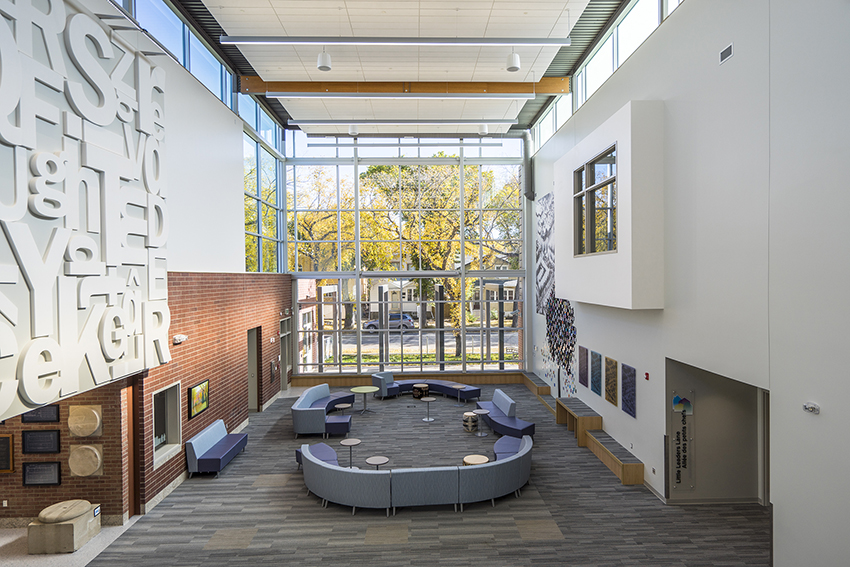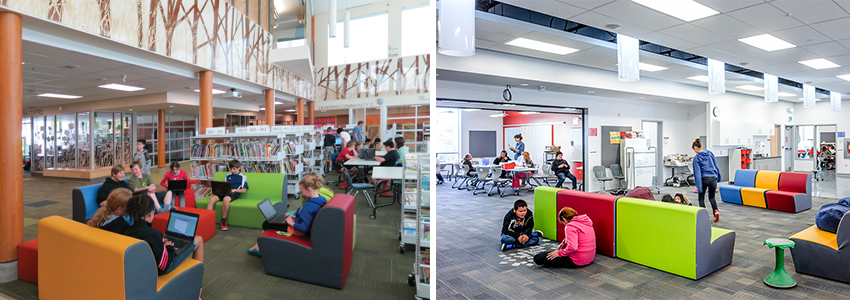
By Greg Hasiuk, MRAIC, MAA, SAA, OAA, AAA, LEED AP
Partner and Practice Leader, Number TEN Architectural Group
What is a “21st Century Learning Environment”? The term is used often in leading educational design circles and has a multitude of connotations and definitions. In my experience working across Western Canada, the term defines a restructuring of the experience of teaching and leaning that is unique to the communities they serve. Much in the same way that home and workplace design has evolved in response to the changing ways we live and work, today’s learning environments need to respond to the effects that technology, culture and the economy are having on the ways that students and teachers collaborate, investigate and learn.

Image: École Connaught Community School Heritage Hall Learning Commons
Of course, the most important ingredient is, and always has been, people. Engaged, creative and committed teachers in a supportive work environment, combined with parents and community members who feel welcomed and informed, are prerequisites to success. Research tells us that facilities that are well maintained and clean give students and community members confidence that educators care and learning matters.
Research tells us that healthy schools with clean fresh air, plentiful natural light and views, and environmentally friendly building materials and cleaning practices help promote better student and teacher engagement and reduces absenteeism for both students and teachers. But how can the design of our new schools take the next step in helping students and teachers reach their full potential heading into a rapidly changing future? The answer is to look beyond the “cells and bells” tradition of the one-room-schoolhouse and towards a more flexible approach to teaching and learning.
I once heard a wise educator say, “every child is a bag of complexity”. Research tells us that people learn in a multitude of “learning modalities” and the design of our schools have not traditionally supported this complexity. Creating a variety of learning spaces that are not just a series of isolated classrooms connected by an empty hallway, and following the adage “learning happens everywhere”, are important core principles in addressing this issue. Some of the core principles of good 21st Century Learning Environments are:
1. Safety & Comfort: Good design creates physical and psychological safety.
2. Flexibility: Good design reflects our current understanding of how students learn, but is also flexible enough to adapt as that understanding evolves. Every space is a learning space.
3. Movement: Good design supports movement across spaces.
4. Transparency: Good design supports high levels of visibility in both formal and informal areas.
5. Sustainability: Good design incorporates sustainable design concepts.
6. Inspiration: Good design inspires the heart and the senses.
7. Connection to Nature: Good design connects with the natural environment.
8. Shared Ownership: Good design invites shared ownership of learning, pedagogy and space.
9. Local Signature: Good design tells a story that connects with the context, geography, people and history of the school community.
10. Health & Well-being: Good design ensures that a healthy environment is provided for all users.
To achieve these core principles in a meaningful way it is important to engage teachers, administrators, students and their communities in a process of exploration and discovery. Understanding the strengths of a community and their shared history and future aspirations, is vital in creating an environment that has a meaningful local signature and shared ownership. There are many important ingredients that go into the making of a flexible learning community. Building active neighborhoods of teachers and students requires the proper combination of learning and support spaces to promote a sense of belonging and shared purpose. 
Image: (left) Douglas Park School Commons | (right) Seven Stones Community School Flexible Learning Community Commons